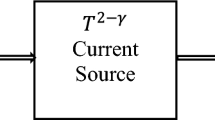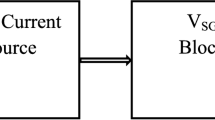Abstract
This work presents a computer-aided design (CAD) approach for voltage reference circuits by controlling main characteristics, such as temperature coefficient, power consumption, mismatch caused by the manufacturing process, transistor area and output noise. The CAD tool and the proposed methodology allow the designer to obtain accurate and optimum initial circuit sizing, thereby reducing the large number of computer runs usually required in voltage reference circuit designs. An illustrative example was carried out in a 180 nm CMOS process and verified by post layout simulations, whose results were in close agreement with the tool predictions, as shown in this paper. The reference circuit achieves an output voltage of 500 mV, a temperature coefficient of 15.19 ppm/\(^\circ \)C over the temperature range of -40 \(^\circ \)C to 100 \(^\circ \)C, a maximum quiescent current of 5 \(\mu \)A, a power supply rejection ratio of -57 dB, and a line regulation of 0.250 % from 1.2 V to 1.8 V supply voltage. The chip occupies an area of 0.072 mm\(^2\).














Similar content being viewed by others
References
Arnaud, A., & Galup-Montoro, C. (2004). Consistent noise models for analysis and design of cmos circuits. IEEE Transactions on Circuits and Systems I: Regular Papers, 51(10), 1909–1915. doi:10.1109/TCSI.2004.835028.
Colombo, D. M., Wirth, G., & Bampi, S. (2014). Sub-1 v band-gap based and mos threshold-voltage based voltage references in 0.13 \({\mu }\)m CMOS. Analog Integrated Circuits and Signal Processing, 82(1), 25–37. doi:10.1007/s10470-014-0343-8.
Duan, Q., & Roh, J. (2015). A 1.2-v 4.2-ppm/\(\circ \)C high-order curvature-compensated CMOS bandgap reference. IEEE Transactions on Circuits and Systems I: Regular Papers, 62(3), 662–670. doi:10.1109/TCSI.2014.2374832.
Galup-Montoro, C., & Schneider, M. C. (2007). Mosfet parameter extraction. Mosfet Modeling for Circuit Analysis and Design. River Edge, NJ: World Scientific Publishing Co. Pte. Ltd. (Chap. 11).
Harrison, W., Connelly, J. A., & Stair, R. (2001) An improved current-mode CMOS voltage reference. In 2001 Southwest Symposium on Mixed-Signal Design, 2001, SSMSD (pp 23–27). doi:10.1109/SSMSD.2001.914931.
Kinget, P. (2005). Device mismatch and tradeoffs in the design of analog circuits. IEEE Journal of Solid-State Circuits, 40(6), 1212–1224. doi:10.1109/JSSC.2005.848021.
Klimach, H., Arnaud, A., Galup-Montoro, C., & Schneider, M. (2006). Mosfet mismatch modeling: a new approach. Design Test of Computers, IEEE, 23(1), 20–29. doi:10.1109/MDT.2006.20.
Kok, C. W., & Tam, W. S. (2013). CMOS Voltage References: An Analytical and Practical Perspective. Singapore: Wiley-IEEE Press.
Leung, K. N., & Mok, P. K. T. (2002). A sub-1-v 15-ppm/\(\circ \)C CMOS bandgap voltage reference without requiring low threshold voltage device. IEEE Journal of Solid-State Circuits, 37(4), 526–530. doi:10.1109/4.991391.
Ma, B., & Yu, F. (2014). A novel 1.2-v 4.5-ppm/\(\circ \)C curvature-compensated cmos bandgap reference. IEEE Transactions on Circuits and Systems I: Regular Papers, 61(4), 1026–1035. doi:10.1109/TCSI.2013.2286032.
Ray, B., Pal Chaudhuri, P., & Nandi, P. (2002). Efficient synthesis of ota network for linear analog functions. IEEE Transactions on Computer-Aided Design of Integrated Circuits and Systems, 21(5), 517–533. doi:10.1109/43.998624.
Rossi-Aicardi, C., Oreggioni, J., Silveira, F., & Dualibe, C. (2011) A MOSFET-only voltage source with arbitrary sign adjustable temperature coefficient. In New Circuits and Systems Conference (NEWCAS), 2011 IEEE 9th International (pp 366–369). doi:10.1109/NEWCAS.2011.5981246.
Schneider, M. C., & Galup-Montoro, C. (2010). CMOS Analog Design Using All-Region MOSFET Modeling. Cambridge: Cambridge University Press.
Tobey, M., Gialiani, D., & Askin, P. (1976). Flat-band voltage reference. US Patent 3,975,648.
Vladimirescu, A., Zlatanovici, R., Jespers, P. (2006) Analog circuit synthesis using standard EDA tools. In Proceedings of the 2006 IEEE International Symposium on Circuits and Systems, 2006. ISCAS 2006 (4 pp.). doi:10.1109/ISCAS.2006.1693814.
Xia, X., Xie, L., Sun, W., & Shi, L. (2009). Temperature-stable voltage reference based on different threshold voltages of nmos transistors. Circuits, Devices Systems, IET, 3(5), 233–238. doi:10.1049/iet-cds.2008.0292.
kun Zhou, Z., Zhu, P. S., Sh, Y., ying Wang, H., M, Y. Q., zhu Xu, X., et al. (2012). A CMOS voltage reference based on mutual compensation of VTN and VTP. IEEE Transactions on Circuits and Systems II: Express Briefs, 59(6), 341–345.
Acknowledgments
This work was supported by the Brazilian research funding agencies CNPq and FAPERJ.
Author information
Authors and Affiliations
Corresponding author
Appendix - Mutual Compensation Approach
Appendix - Mutual Compensation Approach
Using two CTAT generator circuits as shown in Fig. 3, we obtain CTAT voltages given by
where
The mutual compensation can be derived assuming that \(V_{CTAT2}(T)\) minus \(V_{CTAT1}(T)\) does not change with temperature, which can be established by the conditions
where \(V_{IOAT}\) is the desired output voltage and \(T_o\) is the room temperature. Combining Eqs. (30) and (31), we obtain,
Now, fixing the gain \(K_1\) and the function \(F_1\) through the inversion level \(i_{f1}\), as in Eq. (2), yields
Therefore, by using the calculated values for \(K_1\), \(K_2\), \(F_1\) and \(F_2\), a mutual compensation (Eq. (13)) that generates the voltage \(V_{IOAT}\) at the output of the reference is achieved.
The proposed technique based on the above equations takes advantage of the second term of Eq. (29), as follows. Since the thermal voltage (\(k_BT/q\)) has PTAT behavior and \(F(i_f)\) increases monotonically with \(i_f\) (see Fig. 15), the inversion level can be used to adjust the temperature influence according to Fig. 4. As illustrated in Fig. 16(a), an increase of the inversion level \(i_{f4,2}\) makes it possible to reduce the temperature influence and increase the value of the voltage \(V_{G4,2}\). Consequently, by multiplying \(V_{G4,2}\) by the factor \(K_2>1\), we can increase the temperature influence again, and create a voltage \(V_{CTAT2}\), which decreases with the temperature at practically the same rate as that of the voltage \(V_{CTAT1}\) (produced by \(K_1 V_{G4,1}\)). Finally, the difference between \(V_{CTAT2}\) and \(V_{CTAT1}\) yields \(V_{IOAT}\) (Eq. (30)). \(V_{IOAT}\). In Fig. 16(b) we present an illustrative numerical example in which fixing \(V_{IOAT}\), \(K_1\) and \(F_1\), the required values of \(K_2\) and \(F_2\) are obtained. To reduce power consumption, \(F_1\) should be as low as possible, which is limited by the value of \(V_{G4,1}\) at maximum temperature, thereby ensuring the correct operation of \(M_{4,1}\).
Rights and permissions
About this article
Cite this article
Olivera, F., Petraglia, A. A Computer-Aided Approach for Voltage Reference Circuit Design. Analog Integr Circ Sig Process 89, 511–520 (2016). https://doi.org/10.1007/s10470-016-0831-0
Received:
Revised:
Accepted:
Published:
Issue Date:
DOI: https://doi.org/10.1007/s10470-016-0831-0






